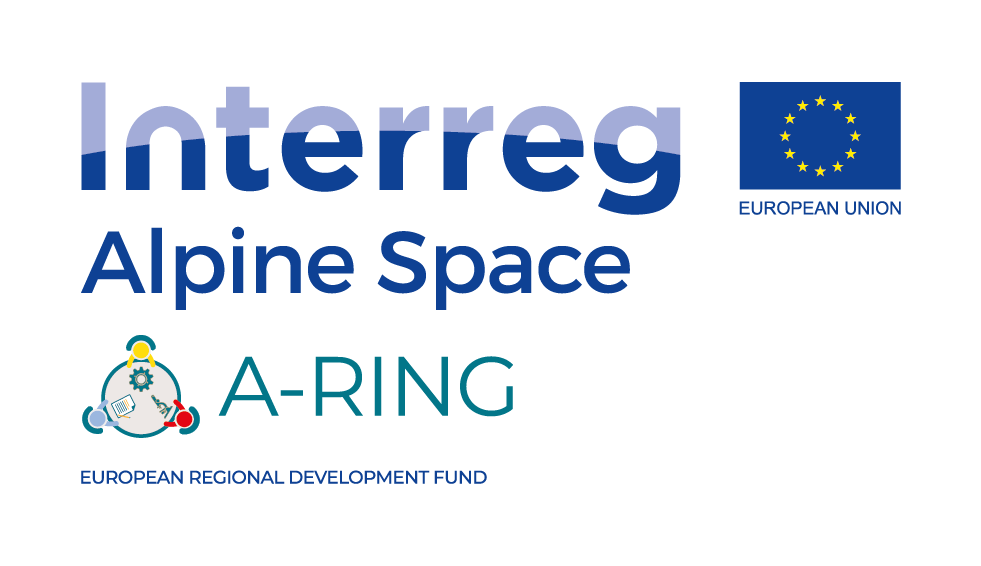
Overview
There is no strategic transnational collaborative framework on topics of specific Alpine importance, such as digitalisation, climate change or biodiversity conservation, neither between public authorities nor between academia and business sectors. Moreover, transnational R&I projects in those areas remain limited. A-RING addressed this need by fostering the alignment between different R&I policy initiatives and institutional frameworks. An innovative bottom-up process was established: gathering expectations from business sectors, the innovation potential from academia and developing a model for a successful policy process to ensure that citizens’ needs are addressed.
Factsheet
- 2014 – 2020
- Well-Governed
- Increase the application of multilevel and transnational governance in the Alpine Space
-
- Group 1: To develop an effective research and innovation ecosystem
- 10/2019
- 06/2022
- 1.404.421 EUR
- 1.147.996 EUR
Outcomes
-
Blueprint for Alpine R&I Agenda
StrategyThe blueprint is a strategic document that defines an approach for the Alpine Region for the creation of a shared research and innovation agenda, through prioritisation of R&I topics for the activation of a transnational synergic and complementary collaboration.A Blueprint serves the function of providing a process model or design for a transnational Strategic Research and Innovation Agenda (SRIA). It provides guidance on both process and content for achieving the SRIA. In terms of content, the Blueprint provides indications on the main components or building blocks of the SRIA document and how these can be structured effectively to build on each other. In terms of process, the Blueprint provides guidance on the appropriate structures for steering these efforts and providing strategic oversight, engaging all relevant stakeholders, building consensus and ownership and for generating the required content. The Blueprint paves the way for the SRIA, by instilling a systematic, iterative, and learning approach and the guiding principles of openness and inclusiveness in the SRIA co-design. The effectiveness of the Blueprint depends on the extent to which it is fine-tuned to the type of SRIA which is envisaged, required and feasible for the setup in question. This will be guided by the steering team, the specific context, and the stakeholder community. -
Alpine R&I Chart
NetworkThe Alpine Research and Innovation Chart (Short: Alpine R&I Chart) aims on presenting an action plan for transnational cooperation network among academia and business sector representatives with the goal to strengthen AR Research and Innovation.The Alpine R&I Chart is accordingly outlining tested approaches and public services to support the flourishing of cross-border relations. Mechanisms of matchmaking describe the construction of useful events to match cross-regional partners for research projects. Thereon building seed lab events present the design thinking approach to develop innovative ideas, giving new project consortia a mechanism on developing ideas for joint projects. The overall objective is to ensure an innovative alpine area. Within the chart, it is outlined how government institutions can support reaching this goal by bringing institutions together and fostering research projects. It therefore contains a visualisation of functional connections/relations gathered from the Ecosystem Relation Tool Model on joining forces within the Alpine area. Aiming on building strong collaborations, which support the innovative growth of the entire region by delivering new ideas, solutions and products. A list of useful services describe the urge for a joint online presentation as a specific product to support the manifesting of S3 approaches, the development of alpine collaborations and joining Alpine forces by presenting projects results. -
A-RING Policy brief
ToolThe aim of this Policy Brief is to provide public administrations (PAs) of the Alpine macro-region (AR) recommendations to enhance transnational and transregional collaboration in research and innovation (R&I), with specific emphasis on the Smart Specialization Strategy (S3/RIS).The Policy Brief provides a methodology for the design and implementation of a common S3/RIS policy, based on the identification of shared approaches and common R&I priorities. Moreover, PAs will obtain a roadmap to activate S3 transnational mechanisms with the aim of sustaining mutual learning, sharing good practices, and fostering the collaboration in R&I projects. When considering inter-regional cooperation in research and innovation it is important to take into consideration the complexity of the framework in which these collaborations take place, in terms of: - the diversity of public and private organizations involved. - the differences in the legislative framework regulating public and private R&I in the AR countries. - the plurality of funding programs available to sustain R&I at the EU, national and regional level. - the many problems which arise when designing and managing collaboration projects involving similar organization (i.e., firms) or between different organizations (such as firms and universities). The Policy Brief is primarily addressed to PAs operating at national and regional level, which are responsible for the design and implementation of S3. Moreover, R&I is carried out for the most part by research institutions and firms. PAs are considered for their role as funders and regulators, which influences the amount of public and private resources invested in R&I and their direction, i.e., the areas on which these resources are addressed. The emphasis of the Policy Brief is on the identification of common R&I investment priorities across AR regions and, most of all, on the mechanisms that may support the collaboration between PAs and relevant stakeholders in addressing these priorities.

